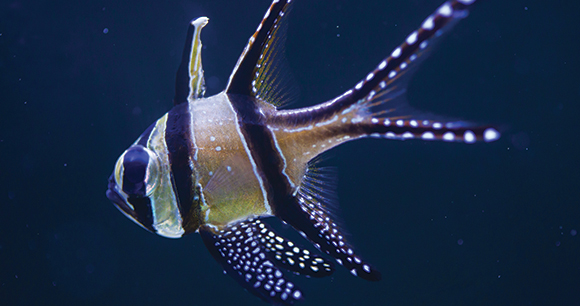The global trade in ornamental fish is a multibillion-dollar business involving the annual global export of around 2 billion fish from 2,500 freshwater and marine species. Many are captured from the wild, often via inhumane or destructive fishing practices (which include dynamiting coral reefs to stun fish for collection). The long-term implications for many targeted species are unknown, but for the individual animals, the trade is deadly—an estimated 98 percent of wild-caught fish die within one year of capture.

The Banggai cardinalfish, a small and iridescent fish with striking spots and black stripes, native only to the Banggai archipelago in Indonesia, is one species whose continued existence in the wild is threatened by the relentless demands of the global ornamental fish trade. First described in 1933, the Banggai cardinalfish did not attract the serious attention of the aquarium trade until the mid-1990s. Since then, however, millions have been snatched out of their wild homes to fill private and public aquariums throughout the world. In the early 2000s, up to 1.4 million cardinalfish were being removed from the archipelago each year, contributing to an estimated 90 percent decline in species abundance and the eradication of some local populations. As the species is largely sedentary, it is unlikely that wild cardinalfish will ever naturally recolonize vacant habitats. To make matters worse, scientists have estimated that up to 80 percent of wild-caught cardinalfish die before they are even exported from Indonesia.
Banggai cardinalfish shelter from predators among the spines of sea urchins, the tentacles of anemones, and the branches of soft corals. Their plight, therefore, is exacerbated by overcollection of these species as well, and the further degradation of coral beds from ocean warming and poor land use practices releasing large amounts of sediments into coastal habitats.
Despite the National Marine Fisheries Service’s 2016 listing of the species as threatened under the Endangered Species Act, the United States remains one of the largest markets for Banggai cardinalfish. In 2019, according to government data, over 177,000 cardinalfish were imported, with nearly 99 percent taken from the wild. When a species is listed as endangered under the ESA, there is an automatic prohibition on “take” (which includes collection). When NMFS lists a species as threatened, however, an additional step is required to ban take: publication by the agency of regulations known as a “4(d) rule.”
In 2021, after NMFS failed to publish a 4(d) rule for Banggai cardinalfish, AWI, the Center for Biological Diversity, and Defenders of Wildlife petitioned the agency for a rule to ban the import, export, and US sale of the species. In August 2023, NMFS responded by proposing a 4(d) rule that would ban import and export of Banggai cardinalfish, but allow domestic sales of the fish to continue.
Banning import and export is a welcome first step toward stemming the demand for wild specimens of this species. Nevertheless, AWI and colleagues contend that NMFS should strengthen the proposed rule by also banning the sale of Banggai cardinalfish in this country. A domestic market leaves the door open for wild-caught fish to be smuggled into the country for sale. Shutting that door would help ensure the continued wild existence of this diminutive but spectacular fish.